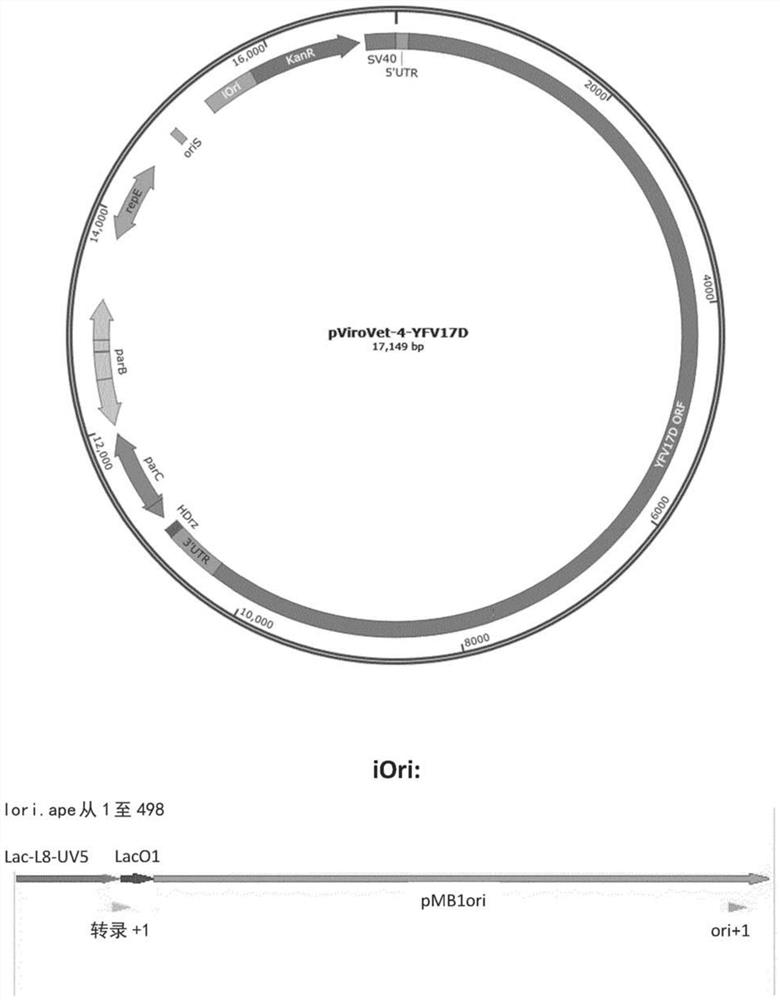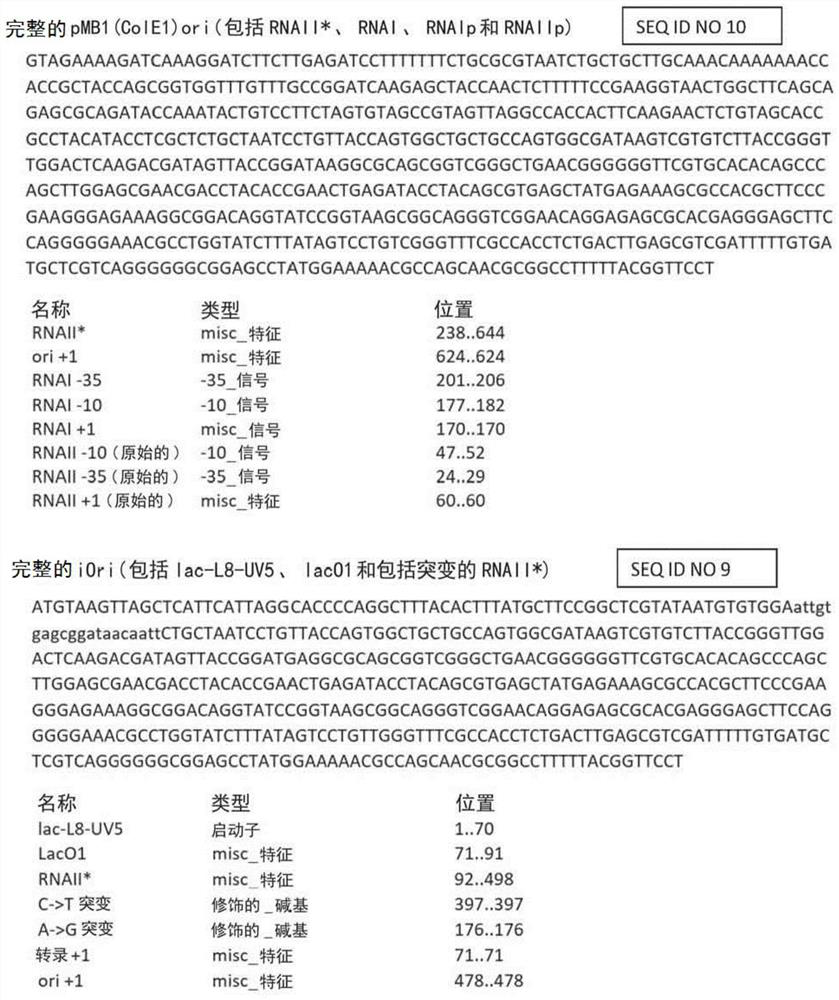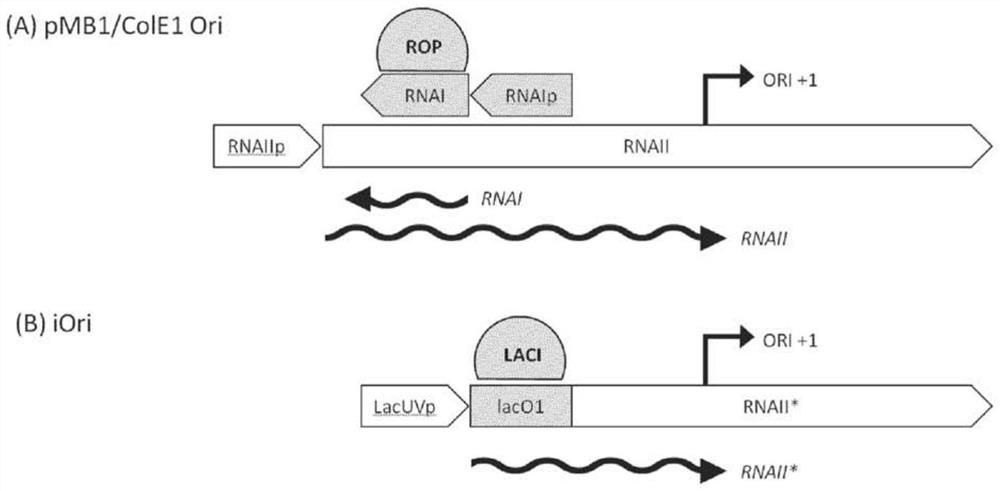Macrocarriers and methods for high throughput production
A carrier and culture medium technology, applied in the field of carriers and high-yield production of large carriers, can solve the problem that BAC is not allowed to be obtained
- Summary
- Abstract
- Description
- Claims
- Application Information
AI Technical Summary
Problems solved by technology
Method used
Image
Examples
Embodiment 1
[0218] Example 1: Comparison of pMB1(ColE1) Ori and iOri
[0219] In pMB1(ColE1)Ori (see SEQ ID NO 10), RNAII DNA is transcribed from its cognate upstream promoter RNAIIp to generate the RNAII transcript. RNAII was used as a primer to initiate DNA synthesis at the Ori+1 start position of plasmid DNA. Expression of RNAII is regulated post-transcriptionally by the incorporation of complementary antisense RNAI. RNAI is expressed by the RNAI gene, which is located within the RNAII gene in the reverse orientation from its own RNAIp promoter. The plasmid-encoded ROP protein stabilizes the RNAI-RNAII duplex and, in this way, further limits the replication of the plasmid DNA ( Figure 2-3 ).
[0220] In iOri, expression of the 5'-end truncated RNAII* is initiated from the heterologous LacUVp promoter. The RNAII sequence is truncated by deleting the entire RNAI gene, and RNAI is not expressed. Expression of RNAII* is regulated at the transcriptional level by the binding of the LAC...
Embodiment 2
[0221] Example 2: Effect of point mutations in RNAH* of iOri on plasmid production.
[0222] have as figure 1 A plasmid of the indicated structure (pViroVet-4-YFV17D with mutated iOri) or with figure 1 Plasmids of the structures shown, in which the mutated iOri is replaced by wild-type iOri (i.e. iOri as in figure 2 As shown, no point mutation C->T at nucleic acid position 397 and point mutation A->G at nucleic acid position 176) (unmutated iOri) were used to transform BL21 bacteria.
[0223] Phosphate buffered LB medium was inoculated with two different bacterial clones transformed with pViroVet-4-YFV17D (pVV* and pVV4) with mutated iOri and one bacterial clone transformed with pViroVet with unmutated iOri - 4-YFV17D transformation (pVV-wt iOri) and incubation overnight in shake flasks.
[0224] Measure the OD of the bacterial culture the next morning 600 , the bacteria were diluted to OD in fresh medium supplemented with 1% glycerol in a fermenter vessel 600 for 2. Ba...
Embodiment 3
[0226] Example 3: Effect of biomass level on yield of vectors as taught herein upon induction of replication
[0227] have as figure 1 Plasmids with the indicated structure (pViroVet-4-YFV17D) and containing iOri were used to transform BL21 bacteria and glycerol stocks were prepared using existing techniques, e.g. as in the transformation protocol for BL21 competent cells (DE3) at New England BioLabs Inc. described in, see https: / / international.neb.com / Protocols / 0001 / 01 / 01 / transformation-protocol-for-b121-de3-competent-cells-c2527 , and as in the addgene homepage https: / / www.addgene.org / protocols / create-glycerol-stock / The protocol for creating bacterial glycerol stocks for long-term storage of plasmids is described above.
[0228] Table 1 shows the effect of biomass level on the yield of plasmids of the invention upon induction of replication.
[0229] OD at inoculation 600
OD at induction 600
OD at harvest 600
Yieldmg / l 0.1 1 2.57 0...
PUM
 Login to View More
Login to View More Abstract
Description
Claims
Application Information
 Login to View More
Login to View More - R&D
- Intellectual Property
- Life Sciences
- Materials
- Tech Scout
- Unparalleled Data Quality
- Higher Quality Content
- 60% Fewer Hallucinations
Browse by: Latest US Patents, China's latest patents, Technical Efficacy Thesaurus, Application Domain, Technology Topic, Popular Technical Reports.
© 2025 PatSnap. All rights reserved.Legal|Privacy policy|Modern Slavery Act Transparency Statement|Sitemap|About US| Contact US: help@patsnap.com



